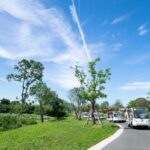The Liangzhu Ancient City ruins date back to between about 5300 and 4300 years ago. It is located in Yuhang District, Hangzhou City, Zhejiang Province, China. It is located in the plain of the river network in front of the mountain at the eastern end of Tianmu Mountain in the Taihu Lake area in the lower reaches of the Yangtze River. It is an important representative of early regional civilizations in China.
As the center of power and belief of Liangzhu culture, the Liangzhu Ancient City ruins are a series of related ruins such as a large-scale city site built between about 3300-2300 BC, a complex peripheral water conservancy system, and graded cemeteries (including altars), as well as unearthed objects mainly consisting of a series of jade wares with symbolic beliefs and systems. It reveals that in the late Neolithic period in the Taihu Lake area in the lower reaches of the Yangtze River, there once existed a regional early state with rice farming as the economic support, obvious social differentiation and unified beliefs. With its early time, high achievements and rich content, it shows the outstanding contributions made by the Yangtze River Basin to the ‘pluralistic integration’ characteristics of the origin stage of Chinese civilization. It fills the gap of Neolithic urban archaeological sites in East Asia in the World Heritage List and provides a unique witness for China’s 5,000-year history of civilization. Therefore, it is known as a famous place that proves the 5,000-year history of Chinese civilization. On July 6, 2019, the Liangzhu Ancient City ruins were officially named as a ‘World Cultural Heritage’. The Liangzhu Ancient City Ruins Park is located in Pingyao Town, Yuhang District, Hangzhou City, covering an area of about 14.33 square kilometers, including the city site area, Yaoshan ruins and peripheral water conservancy system ruins within the scope of the world cultural heritage Liangzhu Ancient City ruins. The city site area of the Liangzhu Ancient City Ruins Park is the core part of the park. It is composed of the palace area, inner city and outer city, presenting a concentric triple layout structure. Ancient river channels run through it. The total area of the city site is 631 hectares, and the total earthwork volume of artificial accumulation is about 7.17 million cubic meters. The palace area is located in the center of the city site. The terrain is relatively high and open, covering an area of about 39 hectares. It is the main place where the higher rulers lived and activities in the Liangzhu period. The inner city is enclosed by city walls. The plane is slightly rectangular with rounded corners. It is about 1910 meters long from north to south and about 1770 meters wide from east to west, covering an area of 280 hectares (including the palace area). Centered on the palace area, there are ruins such as cemeteries, residential sites (including handicraft workshops), terraces and ancient river channels in the inner city. The outer city is located outside the inner city. It is composed of 17 terraces distributed intermittently to form a semi-closed outer city outline, including residential workshop and tomb relics, covering an area of about 351 hectares. The terraces of the outer city and the river network passing through it form a water town landscape living by the water. The Yaoshan ruins are located on the top of a hill about 5 kilometers northeast of the city site. It is a composite site of an altar and high-grade tombs and belongs to the early Liangzhu culture.The tombs in the Yaoshan Cemetery are all vertical pit tombs, buried in two rows, north and south, with 754 pieces (sets) of funerary objects unearthed, including 678 pieces (sets) of jade.

The peripheral water conservancy system was a unified urban water resource management project planned at the beginning of the construction of Liangzhu Ancient City, composed of 11 artificial dam bodies and natural mountains, and overflow channels of the high dam in the valley mouth, the low dam in the plain, and the long embankment in front of the mountain. The total earthwork volume is 2.88 million cubic meters, making it one of the earliest large-scale water conservancy project sites discovered in China to date, and also one of the earliest low dam systems found in the world.

Open all year round from 09:00 to 17:00, with last admission at 16:00.

Preferential policies for children: Free for children under 6 years old (inclusive) accompanied by an adult; 30 yuan per person for children between 6 years old (exclusive) and 18 years old (exclusive) accompanied by an adult.









